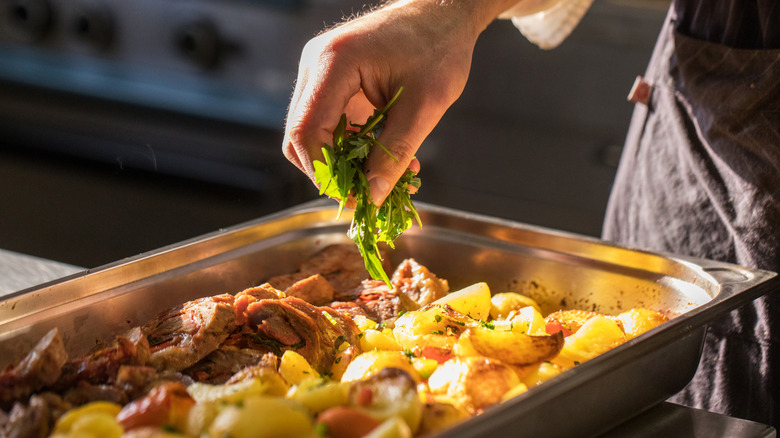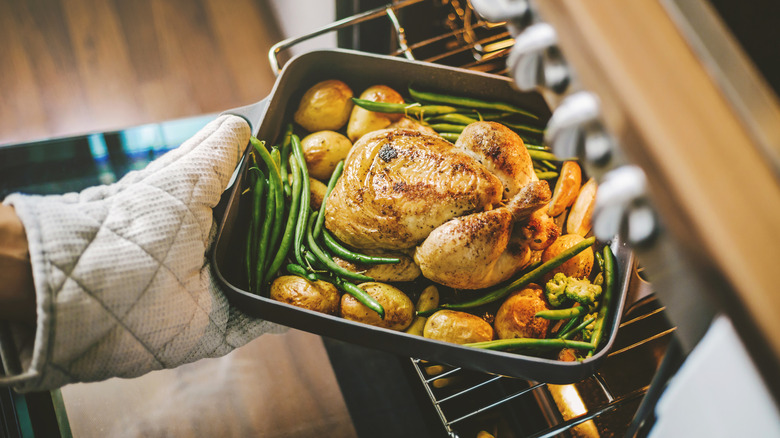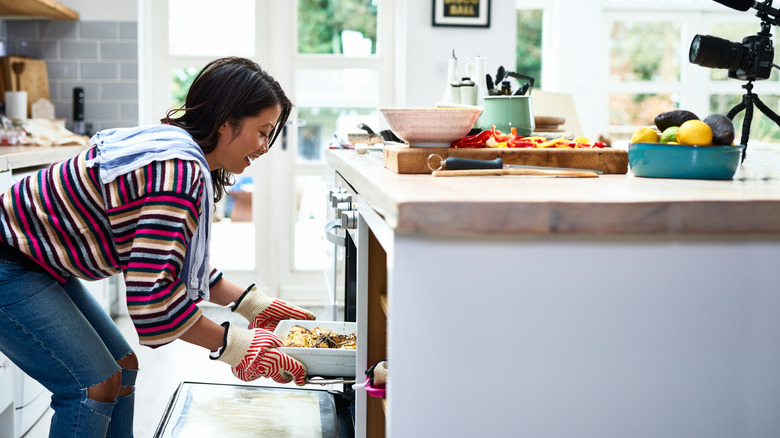How To Cook Recipes With Different Temperatures In The Same Oven
It's a scenario that too many home gourmands know well. One recipe calls for an oven that's set to 375 degrees Fahrenheit, another demands temps of 325 degrees Fahrenheit, and a third recipe — well, it's happy as a lark if it gets to sit right in the middle at 350 degrees Fahrenheit. If you're envisioning a world where each dish has to wait its turn to go into the oven, a plan that could take hours or even days to execute, consider another option. Make all the temperatures meet in the middle and cook everything at the same time.
As it turns out — with the exception of baked goods, which really do need to be cooked at the exact temperatures their recipes call for — roasts and other dishes have a little bit of leeway. In other words, it's perfectly okay to set the oven at 350 degrees Fahrenheit and fill the box to the brim with a roast, potatoes au gratin with Velveeta, and some kind of casserole or veggies, too. Many standard ovens aren't that standard at all. That is to say, it isn't unusual for them to be off by as much as 25 degrees Fahrenheit — something you can take advantage of if you cook your recipes at a meet-in-the-middle temperature.
What to put into the oven first
You can cook multiple things at once, but there is still such a thing as an order of operations in this scenario. The cooking times on your recipes will likely vary. Planning your dinner with these factors in mind gives you the biggest chance for success if you're cooking different dishes together.
The food that requires the most time in the oven needs to be put into the oven first. As an example, if you want to properly cook a pot roast, you'll need at least three hours of cooking time before it's done. Therefore, it should go into the oven before any potatoes, as well as most casseroles or dry roasted vegetables you make. So set the oven to the desired temperature and then fill it first with the roast, then with the spuds an hour or two later, followed by the veggies or casserole. Adhering to a plan like this allows you to pull everything from the oven at roughly the same time for dinner. You shouldn't need to adjust the temperature of the oven, just the times you put your dishes in to cook.
Finally, there's one caveat here. If you have dinner rolls to bake and the temperature is otherwise compatible with everything else, they can go into the oven with the rest of the food. Just make sure that you put the bread and other baked goods into the oven when it's their "turn" to ensure they get baked thoroughly.
Take advantage of your oven's hot and cool spots
Generally speaking, the warmest parts of your oven are found along its perimeter — on its top and bottom shelves, and at its sides. If you're still harboring some fear that some of your food won't get cooked properly if you use a meet-in-the-middle approach, then use the oven's hottest and coolest spots to good effect.
With a roast, this usually isn't an issue since most people put it on the bottom rack due to how heavy the roasting pan can be, particularly if it's on the fuller side. This position also happens to place the meat near the coils on the bottom of the oven. As for potato or casserole dishes, they'll probably do well on the middle rack. They'll get enough heat to cook without bubbling over. Any leftover dishes that require a higher temperature can go on the top shelf.
Finally, keep in mind that even the most ambitious home cook never stuffs an oven to the gills. If you want your dishes to cook evenly, you need air flow, so leave some room on all sides of each of your dishes. If your oven has a convection feature to circulate the air, even better! Be sure to use this option in order to maximize the air flow. If you do, you'll find that meeting in the middle is just the hack you never knew your cooking needed.


